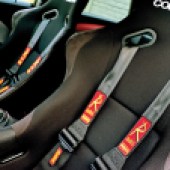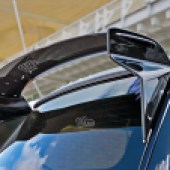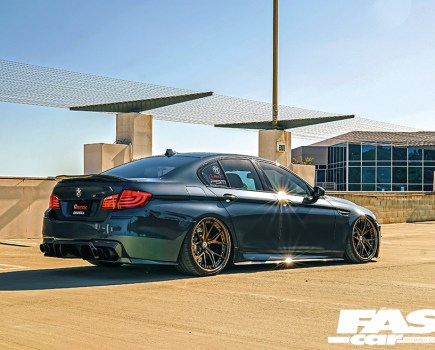More power, less weight and even better to drive, the original Mini Cooper S GP R53 is already a hot hatch icon and, as such, values are beginning to firm up. Here’s what to look out for when buying and tuning one.
Hot hatch specials are two a penny these days. Manufacturers think nothing of junking non-essential standard kit – even the rear seats – to up the performance, tighten the handling and increase the presence of their models at track days across the country. But back in 2006, the idea of a numbered, two-seater version of the Mini Cooper S R53, with unique suspension and body kit, seemed nothing but a rumour throughout first-generation Mini production.
However, when the GP was confirmed at the 2006 Mini United event in Misano, Italy, all the UK cars quickly sold out. Owners liked the giant-killing package. In fact, it worked so well that BMW brought back the GP for the second-generation Mini in 2012. It did so again in 2020, with the fastest yet, based on the current third generation F56 hatch (check out our F56 JCW buyer’s guide).
A brief history of the Mini Cooper S GP R53
Launched in Summer 2006, just one version of the Mini Cooper S R53 with John Cooper Works (JCW) GP kit was available. Power came courtesy of the Cooper S’ supercharged 1.6-litre Tritec four-cylinder, with JCW parts. This included a faster-spinning supercharger, revised intake system, uprated injectors and a freer-flowing stainless-steel exhaust. This resulted in 218hp at 6250rpm along with 184lb ft of torque at 4600rpm. That meant a 0-62mph time of just 6.5 seconds, along with a 150mph top speed. Assembled by the legendary Italian coachbuilding and manufacturing company Bertone, outside this Cooper S had a new and unique aerodynamic package. This included front and rear aprons, chunky side skirts and the Mini Challenge-style rear wing.
On top of this, there’s the one-off Thunder blue exterior colour with a Pure silver roof. This displays the car’s unique number on the right-hand side, plus Chili red mirror caps. Finally, you can’t miss the lightened four-spoke 18” alloy wheels. The interior is equally special, and the car is just a two-seater, with the area where the back seat used to be taken up by a lidded storage box. There’s also what looks like a rear strut brace over the back suspension, but it adds nothing to the body shell’s stiffness.

Our pick
There is just one R53 Cooper S GP model, and all 460 UK cars are well-equipped. You got heated, leather-trimmed Recaro front seats, air-conditioning, a three-spoke multi-function steering wheel, unique grey instruments, and the car’s individual number on the dashboard.
However, the interior and exterior changes are not the only GP highlights. 50kg lighter than a standard R53 Cooper S, one of the unique weight-saving features of the GP is the lightweight aluminium control arms for the rear suspension. Other GP-specific suspension parts include lower, stiffer springs and different dampers. There is also some ground effect aerodynamics underneath. With the extra power, thankfully the brakes at the front of the GP were uprated to JCW spec; they can be identified by the bigger calipers finished in red.

What to pay
The lucky 460 original GP buyers paid £22,000 for their cars which were delivered between July and September 2006. However, despite still being collectable and sought-after in performance car circles, values dropped as low as £8,000 in the mid-2000s. That’s no longer the case, as prices now start from £10,000 and stretch to £25,000 and at the time of writing this, there weren’t many available to choose from.
The cheapest example was a 90k-mile standard, low roof-number car. While £16,500 will buy you a standard GP with 50k on the clock. Top-priced GPs have the lowest mileage; we spotted one with just 28,000 miles at a dealer, priced at £25,000. However, we’ve seen GPs stored away by collectors with less than 10,000 miles on sale for considerably more than this. Many GPs have been modified, although these are not worth any more, and make sure you’re happy with the work undertaken.

What to look out for on the Mini Cooper S GP R53
Firstly, pull the dipstick and check the oil. All R53 Cooper S models have a thirst for the black stuff, so expect to add 250ml every 1000 miles on a healthy Mini. Start the engine, then listen for any unusual noises. If you hear a slight rattle at the top end, this could equal problems with the hydraulic tappets. It could also mean the timing chain needs tensioning. However, if you can hear a noise from the bottom end as you increase the revs, this could be due to the engine being run low on oil at some point. Cylinder heads are also known to crack if the engine has been allowed to overheat.
The Eaton M45 supercharger is very reliable. However, if you’re looking at a GP with over 90,000 miles that’s not had a rebuild service, it’s a good bargaining point when buying. Also, make sure you check the condition of the supercharger tensioner and belt. They can slip and break. If you hear squeaking on start-up this could be the reason. Next, look at the condition of the oil-filled circular engine mount on the right of the engine. They are known to fail, so check the front crossmember for oily deposits. At the back, the plastic brake fluid reservoir can be prone to leaks.
Check the wheels for kerbing
The GP was fitted with unique, lightweight 18”, four-spoke alloy wheels manufactured by Ronal, originally fitted with Dunlop SP run-flat rubber. These tyres are no longer available, and the run-flat compound makes the ride harsher. Don’t be surprised to find alternative non-run-flat rubber on any GP that you look at. Budget at least £200 a corner for run-flats and less for standard tyres. The wheels themselves should be finished in matt black with polished edges and spokes. These alloys are prone to kerbing, and the lacquer doesn’t stand up well to winter weather, so many will have been refurbed by now.

Stone chips and flaky paint
It might have been built in Italy by Bertone, but the GP feels as solid as any other BMW Mini. The GP, like all Minis, has quite an upright front nose that is prone to stone chips. If there aren’t any and the car has covered serious mileage, then it has probably been resprayed. Also, the GP scoop sticker is prone to fading. It’s easily replaced, but if it looks newer than the rest of the paintwork ask why, as the car might be hiding more serious repairs.
Then, look at the unique front apron. There were warranty problems from launch with flaky paintwork, especially around the silver-painted, turbine-like faux brake ducts. The GP is lower than a standard Cooper S, so check the condition of the front splitter for grounding damage. Like the front splitter, the chunky side skirts are vulnerable to damage. Look for scuffs and stone chips on the bottom edge. The rear window glass is unique to the GP and has special cut-outs for the rear wing. The centre section of the rear wing is made from carbon fibre; make sure it’s free of damage.
Inside, the special interior trim and supportive standard Recaro sport seats stand out; make sure they’re all present and correct. Expect some scuffing to the side bolsters of the seats. The leather is easily caught when getting in and out. However, damage should correspond with the mileage. They’re heated too, so make sure they work.

Modifying a Mini Cooper S GP R53
The GP was already fitted with the smaller JCW pulley for the supercharger. However, this upgrade, the revised intake system, uprated injectors and a freer-flowing stainless-steel exhaust only added up to an extra 8hp over a standard Cooper S JCW. However, the GP’s uprated intercooler can handle the increased temperatures of an even smaller supercharger pulley, such as a 17% Alta pulley, so at £130. This is a relatively easy way of giving your GP more horses.
With that extra power coming from the smaller supercharger pulley at the front of the engine, it’s worth thinking about how the exhaust gasses are exiting from the back. One solution is to upgrade the manifold. This will not only release the exhaust gasses quicker but should make for keener mid-range acceleration too. A Janspeed 4-1 manifold is priced at £384.
Although the GP is fitted with a limited-slip differential as standard, fitting a Quaife Automatic Torque Biasing (ATB) differential alongside any engine modifications is worthwhile. It improves power delivery throughout the rev range over the standard setup, by giving smooth, constant traction. Priced at £726, it’s also recommended that you fit a new clutch and flywheel at the same time, adding to the cost.
Chassis modifications
The GP is fitted with a JCW handling pack. This meant grippier, controlled and far less bouncy handling than a standard R53. But any Mini – including the GP – benefits from further suspension tweaks. Unfortunately, due to the GP’s unusual configuration of suspension components, not all coilovers will fit this MINI. KW Automotive Variant 1 coilovers are recommended; they are high-quality and are pre-set at the factory to give the best balance between sporty driving, comfort, and safety. KW Automotive V1 coilovers cost £974.

The standard JCW brake set-up is decent, but that hasn’t stopped many owners upgrading to the later and bigger Brembo calipers. It seems a cost-effective upgrade too, with refurbished pairs of calipers priced between £400-500 on auction sites. However, if you don’t want to go that far, or keep the original calipers, a simple pad upgrade can make a worthwhile difference.
Styling upgrades
It’s hard to make this R53 stand out any more than standard – every Mini enthusiast knows what it is! However, it’s worth searching out period JCW carbon fibre exterior parts, such as the bonnet scoop, wing mirror caps and boot handle; if you can find them, online auction sites are your friend here. Or, more simply just getting some of the exterior chrome trim colour-coded can give a GP a subtly different OEM+ look.
Another exterior mod that will make any GP stand out is just fitting an aftermarket lightweight set of alloy wheels.
Inside, there’s not much wrong with the GP’s interior. However, we’ve seen owners upgrading the already excellent, standard Recaro leather sports seats for the JCW Sparco bucket seats. Like other OEM first-generation JCW Mini parts, these are getting harder to find. As a result, they are more expensive, with current prices up to £1500 for a pair in reasonable condition.

Verdict
With its pointy handling and sharp, fast steering, you can really make the most of the effervescent supercharged engine. The Mini Cooper S GP R53 must be the ultimate first-generation car. The only real issue is the lack of practicality, with this Mini’s lack of rear seats. However, you could argue the lack of rear legroom with them in place makes the rear seats in the standard car largely useless anyway.
Mechanically, the only potential issues are common with the standard Cooper S and are not major ones. So, it’s possible to run a GP on a reasonably sensible budget, and there are upgrades to improve this giant killer if you feel the need. The Mini Cooper S GP R53 is an excellent and accessible performance package that you’ll enjoy driving. Prices are on the up, plus there seem to be fewer second-hand examples available, so a GP seems to be a good investment.




















